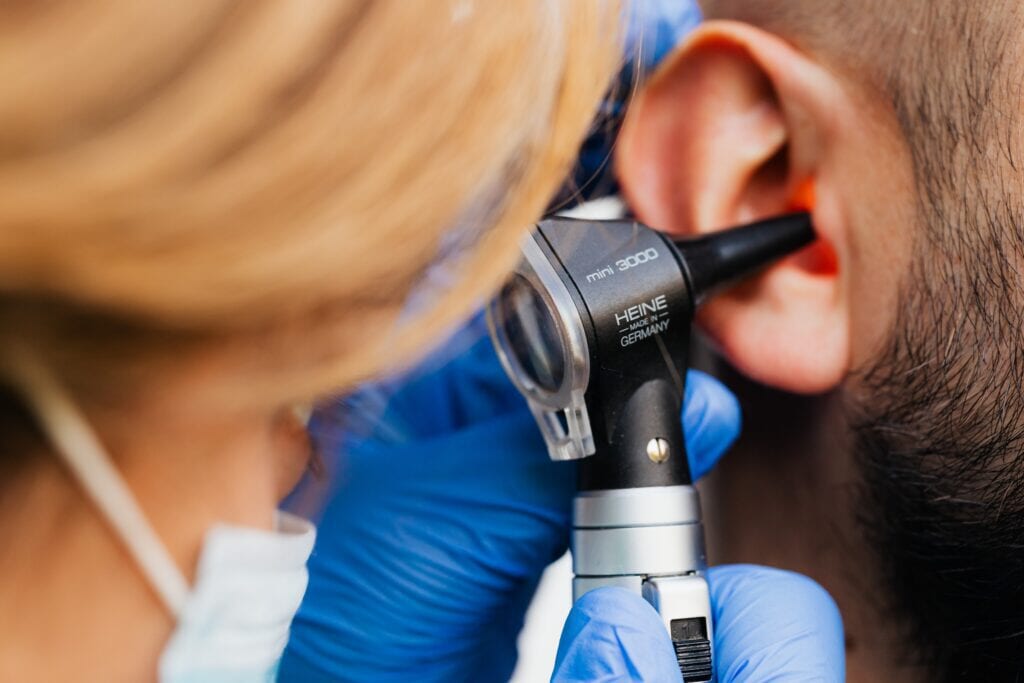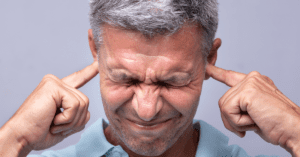If you notice a ringing in your ears, you might visit your doctor to have it checked out. But what if your hearing test came back normal? Even though it’s most often related to hearing loss, subjective tinnitus with hearing that falls within the range of normal is possible.
Is Tinnitus With Normal Hearing Common?
Tinnitus, or a ringing in the ears without any external source of sound, is very common. In fact, just about everyone experiences tinnitus at least once in their life. For most people, it’s a mild experience that resolves within a few minutes. But for 15-20% of the adult population and over 30% of people over the age of 65, it’s a chronic condition that can have a major impact on your wellbeing. Although most tinnitus patients have some degree of hearing loss, about 10% of them have normal hearing thresholds and normal hearing sensitivity as measured by a hearing evaluation.
"Treble Health helped me reduce my tinnitus by about 80%, and now I can live my life again!"


"Treble Health helped me reduce my tinnitus by about 80%, and now I can live my life again!"
– Steve D.
Book a free consultation to learn which Treble Health solution is right for you. Join Steve and thousands more who have found lasting tinnitus relief.
How Is Hearing Evaluated?



In order to evaluate someone’s hearing, most audiologists use the Pure-Tone test, also known as the audiogram or the classical hearing test. This test is often performed by wearing headphones and listening for a beep in one or both ears. This helps determine the quietest sound you can hear at different pitches or the auditory threshold.
What Is The Definition Of Normal Hearing?
If hearing threshold falls within the established normal limits, hearing is classified as normal. This range is relatively wide, so many people with tinnitus might still have technically normal hearing ability. If you’re having a hearing evaluation for the first time, the audiologist will not have any previous results to compare to. If hearing thresholds have shifted but still stayed within the “normal hearing sensitivity” range, the audiologist will have no way of knowing that.
Understanding Tinnitus Patients With Normal Hearing
Normal audiograms with normal thresholds may come as a surprise to tinnitus patients. Some people may believe that their chronic subjective tinnitus is caused by a hearing loss, while others may actually notice hearing loss. Neither are incorrect, although their audiologist may categorize their hearing as normal. A normal audiogram might not tell the whole story about how well your auditory system functions.
Reasons Some Hearing Loss May Go Undetected
Many tinnitus patients with normal hearing tests may have partial hearing damage. This damage might be mild, and not yet pronounced enough to change hearing thresholds or achieve a diagnosis of hearing loss.
History of Noise Exposure



One possible cause of undetected hearing loss is a previous history of noise exposure. Loud noises can range from long-term exposure to high volumes – like loud music or machinery – or one extremely loud sound like a gunshot or explosion. If you are exposed to loud noise on a regular basis, use quality ear protection to avoid early onset permanent hearing loss or tinnitus.
Being around loud noises may lead to damage of the inner ear, called the cochlea. Cochlear damage occurs when sound waves of high intensity damage or destroy tiny hair cells inside it. Outer hair cells in the cochlea work with inner hair cells to transmit the sound information to the auditory nerve fibers. We are born with thousands of outer and inner hair cells, but slowly lose them over time due to normal aging and a lifetime noise exposure.
In order to cause a detectable level of hearing loss that falls outside the normal hearing thresholds, the hair cell loss needs to be substantial. Cochlear damage may be gradual, so noise-induced hearing impairment can go undetected for quite some time.
Otoacoustic Emissions
A specialized test, called OAE or Otoacoustic Emissions, is more sensitive to noise induced cochlear damage than a traditional pure tone test. This test specifically measures the hair cell function inside the cochlea. It uses a soft clicking noise and a specialized microphone measures the emissions that produced by the cochlea in response.
For someone who has been exposed to a lot of noise, it is very common to have changes or reductions in the outer hair cell function of the ear, which in turn results in the reduction of otoacoustic emissions. The otoacoustic emissions test is very sensitive, so it can be used to detect early hearing damage due to noise exposure in tinnitus patients whose hearing loss is not yet evident on the pure tone test.
Jay Hall, a prominent researcher in the field of audiology and hearing science, and his group have studied extensively otoacoustic emissions in tinnitus patients. They found a significant difference in OAE results between the tinnitus group and the control group. Findings showed that over 90% of patients who have tinnitus and normal hearing on the pure tone test show reduced function in the OAE test. In these patients, the cochlear outer hair cells are not technically normal, meaning they are not as functional as they once were earlier in life.
Mild Age-Related Changes



Similarly, age related hearing loss and chronic tinnitus can partly result from cochlear damage due to hair cell loss. In addition, changes take place in the auditory nerve, auditory brainstem (lower part of the brain), and auditory cortex. Hearing changes over the course of a lifetime and tend to become more pronounced over the age of 65.
But not all of these changes take place after age 65. Recent research has uncovered physiological evidence of changes in the auditory system, which begin to take place at a much younger age. For many people, these changes start in their 50s or even 40s. This can be due to lifetime noise exposure or part of the aging process.
Many people in their 50s and 40s begin to notice difficulty understanding speech when in crowded places like restaurants and parties. In these cases, you may need people to speak louder than the background noise in order to understand it. This relationship between speech and noise is called the signal to noise ratio. The need for a higher signal to noise ratio is another sign of an auditory processing problem associated with what’s called “hidden hearing loss.”
Hidden Hearing Loss
The recently-coined term “hidden hearing loss” refers to various changes in the auditory system, including auditory periphery, auditory nerve fibers, auditory brainstem and central auditory system. This can lead to problems in speech perception and chronic tinnitus, even if you have normal hearing according to a pure tone test. In people with hidden hearing loss, the otoacoustic emissions may reveal a noticeable decrease in the volume or strength of the cochlear emissions.
Cochlear Synaptopathy
Most scientists believe that the mechanism behind hidden hearing loss has to do with problems with how inner hair cells transmit sound information to the auditory nerve fibers. This is described as cochlear synaptopathy. Cochlear synaptopathy can be triggered by aging changes, loud noise exposure, or ototoxic drugs that can damage the ears or lead to hearing loss.
To help diagnose hidden hearing loss, your audiologist may use a specialized test called the auditory brainstem response. This test falls under the category of auditory evoked potentials (AEP). AEP tests help pinpoint hearing problems by using electrodes while sounds are played into the ears. This test helps to evaluate the auditory system beginning with the auditory nerve all the way to the central auditory system by examining the electrical activity generated by these structures. This information can be used to assess the synaptic activity between the inner hair cells and the auditory nerve.
Extended High Frequency Region and Inter-octave Frequencies
Yet another possible explanation for tinnitus patients with normal hearing thresholds could be a decline in high frequency hearing sensitivity. These high pitched sounds are usually the first frequencies to be affected by age-related hearing loss. This extended high frequency audiometry is not usually performed in routine hearing tests, so some people may not be identified as having reduced high frequency hearing sensitivity.
Additionally, some hearing evaluations may not include all frequencies available for testing, such as inter-octave frequencies. Testing that does include inter-octave frequencies can be more precise. Your hearing loss may only exist at one particular frequency, and unless that pitch is checked during a routine hearing test, it may not be identified.
If you’re experiencing tinnitus, you may want to ask your audiologist about including high frequency audiometry and inter-octave frequencies when you have your hearing tested. With regards to high frequency audiometry, since most tinnitus is high ringing sound, this test will often uncover that the tinnitus pitch matches the frequency range of hearing loss.
Tinnitus Patients – The Take Aways
If you’ve ruled out any underlying conditions and your hearing test results are “normal” but you’re still experiencing subjective tinnitus, there’s a good chance you have hidden hearing loss. There could be some degree of damage, decline, or changes to your hair cells in the cochlea. For many people, this is the “aha” moment that tinnitus is actually coming from the ears, and not something else.
When the cochlea is damaged, it sets off a cascade of events where an incomplete or distorted sound signal is sent to the brain. In the absence of a complete auditory picture, your brain compensates and sends the signal as tinnitus.
This brings the signal into the realm of perception, and you could fall into a vicious cycle of forming negative thoughts and habits around tinnitus. This can then create additional problems like stress, worsening mental health, and a reduced quality of life. With or without known hearing loss, you should have your auditory processing and hearing ability diagnosed by specialized audiological tests.
Treatment For Tinnitus In Patients With Normal Hearing
Regardless of the reasons for tinnitus, people with normal hearing thresholds who have bothersome chronic tinnitus should pursue tinnitus treatment. Start with a complete audiological evaluation and, if necessary, a medical evaluation. The next step would be to begin a tinnitus treatment program, such as tinnitus retraining therapy so tinnitus can fade into the background.
Next Step: Book Free Consultation
- 75% of patients reduced their tinnitus within three months after following our recommendations.
- "I feel like Treble Health literally gave me my life back." - Randy S. (verified customer)
- Join thousands of people who have reduced their tinnitus after scheduling a free consultation.


















